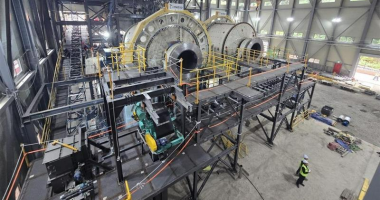- ASX-listed mobile health (mHealth) company Advanced Human Imaging (AHI) is moving forward with its planned dual-listing on the NASDAQ exchange
- Listing on the NASDAQ will place Advanced Human Imaging on one of the highest-quality and highest-value exchanges on the planet
- By dual-listing, AHI follows other well-known medical and technology companies such as Mesoblast (MSB), Kazia Therapeutics (KZA), and Heartware
- Dual-listing increases a company’s share liquidity, increases the capital potential of a company, and opens it up to a massive pool of investors
- AHI hopes the high-quality investors on the new exchange realise this potential as the company moves ahead with its dual-listing
ASX-listed mobile health (mHealth) company Advanced Human Imaging (AHI) is moving forward with its planned dual-listing on the NASDAQ exchange, set to open a string of new opportunities for the company.
The exchange is renowned for its focus on technology and innovation. It’s the second-largest exchange in the world by market cap, behind only the New York Stock Exchange.
Eight of the top 10 biggest hedge funds are based in the US, making the NASDAQ their home market.
For comparison, the Australian Securities Exchange currently has a combined aggregate market cap of some $2.6 trillion.
The NASDAQ has a combined aggregate market cap just shy of US$27 trillion (A$37 trillion).
As such, listing on the NASDAQ will place Advanced Human Imaging on one of the highest-quality and highest-value exchanges on the planet.
The quality of investors soon to be exposed to AHI’s stock and technology is unmatched globally.
It’s not uncommon for mHealth stocks to dual-list on the ASX and the NASDAQ given the benefits the US exchange brings.
According to AHI, a recent surge in telehealth across the globe has seen unprecedented demand on mHealth companies to supply a digital means to engage and deliver patient data for care providers and doctors remotely.
At the same time, these companies are experiencing exponential valuation growth as they vie for position in the early intervention and remote care markets.
Companies such as Virta, One Medical, Noom, K Health and Dispatch Health are all seeing valuations for their diagnostic, wearables, and mobile and digital health platforms exceeding US$1.5 billion (A$2 billion).
AHI CEO and Chairman Vlado Bosanac said thanks to the strategic positioning of the company as a health data companion information provider, he did not see the company as a competitor to these big-cap businesses.
“I am building a synergistic data enhancement tool for these organisations to use in partnership with AHI,” Mr Bosanac said.
“As we are a B2B business, they do not see us as a competitor; they see us and a cohesive partner that empowers them to retrieve data remotely, and cost-effectively, with their consumers or patients.”
AHI believes it is well-positioned to attract the interest of US investors with its companion diagnostics mHealth technology and the demand for patient information systems at which the company is at the cutting edge.
AHI in good company
Other ASX-listed businesses to have taken their shares over to the NASDAQ include the likes of Mesoblast (MSB), which announced in 2013 it had been approved for a dual-listing on the prestigious exchange based on its adult stem cell therapy drug development.
Mesoblast followed Heartware, which made wearable tech devices designed to help the heart pump blood through the body. Heartware dual-listed on the NASDAQ and ASX in 2009 and was acquired by global medical technology giant Medtronic for US$1.1 billion in 2016.
Kazie Therapeutics (KZA), formerly known as Novogen, dual-listed in 2015.
Avita Medical Inc (AVH) dual-listed to the NASDAQ in 2020.
In more recent news, Australian buy now, pay later (BNPL) darling Afterpay is also looking to move to the NASDAQ; not in a dual-listing, per se, but more likely by completely de-listing from the ASX to trade solely on the NASDAQ.
How does a NASDAQ listing actually work?
Companies typically have two options when chasing a listing on an overseas exchange: de-list entirely on the ASX and re-list on the new exchange, or dual-list so that shares trade on both exchanges at once.
In either case, the question typically on the minds of investors is: what happens to my shares?
For Advanced Human Imaging, the company has confirmed its plans to dual-list, and details around its specific dual-listing process have been outlined in the company’s F-1 submission to the US Securities and Exchange Commission (SEC) by way of an American Depositary Share (ADS).
The dual-listing of AHI includes an offer of depository receipts to foreign investors. These act for all intents and purposes as stock in the company, though they are technically owned by an exchange-operated entity.
When dual-listing, a company will often offer shares to existing investors first, inviting them to purchase depositary receipts in a pre-determined ratio to the company’s common stock already held.
In AHI’s case, this ratio has not yet been determined upon closing, though a guide has been given in the F-1 of a nine-to-one ratio.
The common stock held by ASX investors will be unaffected except that, once dual-listed, it becomes subject to price changes on both the NASDAQ and the ASX.
Of course, dual-listing in such a way requires a company to raise funds to trade on the second market, to pay listing fees to two exchanges, and it must follow two sets of listing rules.
However, the potential payoff is significant.
Dual-listing increases a company’s share liquidity, increases the capital potential of a company, and — in the case of an ASX-NASDAQ dual-listing — means shares can be traded for longer periods of time on any given day thanks to time zone differences.
An ASX-listed company listing on the NASDAQ gains access to a massive pool of potential investors.
More than this, dual-listing on the NASDAQ increases the public profile of the ASX-listed company in the US, bringing a whole new world of potential supply deals and business partnerships.
The reputation of the NASDAQ is nothing to be scoffed at either. Trading on such a prestigious exchange can bring credibility and validity to a business.
Advanced Human Imaging is hoping to make the most of all of these benefits with its upcoming NASDAQ listing.
AHI on the NASDAQ
AHI will list on the NASDAQ with the help of investment firm Maxim LLC, which helped facilitate more than 140 financings and acted as lead, joint, or co-manager for an aggregate US$6.8 billion (A$ billion) in 2020 alone.
Maxim is the exclusive lead underwriter of AHI’s proposed share offering for its NASDAQ listing.
AHI said in October it had filed an updated registration statement by way of Foreign Issuer Form F-1 with the US Securities and Exchange Commission (SEC). This method effectively acts as a US public offering, but AHI will issue American Depositary Shares (ADSs) in the place of common company stock.
Along with the typical aforementioned benefits of dual-listing on another exchange, AHI’s presence on the NASDAQ places the company in league with the world’s biggest tech and health stocks.
For a company to list successfully on the NASDAQ, it must meet several important requirements around its equity, number of shares and shareholders, public float market value, and number of market makers willing to facilitate the buying and selling of its securities.
As such, while a NASDAQ listing is not guaranteed to succeed, the ability to check these boxes can serve as evidence of a company’s potential.
AHI said in an announcement on Monday, November 1, it had ticked the required boxes and was getting ready to pay its listing fees on the back of a US$15 million (A$19.9 million) capital raising.
AHI is hoping the high-quality investors on the new exchange realise this potential as the company moves ahead with its dual-listing.








